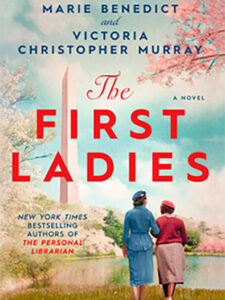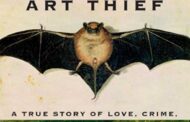BookShort
The First Ladies: A groundbreaking partnership
By Stephanie Miller

Who says strong women can’t collaborate? Outspoken First Lady Eleanor Roosevelt was a capable advocate for civil rights—mostly without support from her husband or Democratic Party leaders—in part because she met, respected, and listened to Dr. Mary McLeod Bethune, a Black educator and activist. Together, they became a formidable pair of “first ladies” for equality and universal dignity.
Written by the authors of “The Personal Librarian,” Marie Benedict and Victoria Christopher Murray, this “The First Ladies” historical novel is a soaring saga of a warm personal and honorable political friendship. Even before she became FLOTUS, Eleanor was daring and relentless in her efforts for many civil causes. She was an early advocate for the rights of African-Americans at a time when most players in Washington were not.
Eleanor made many mistakes by not fully understanding the situation and needs of Black Americans. To her credit, she apologized, listened, and learned. A lot fewer records survive to tell the story of Mary Bethune. She was an incredibly wise, capable, and successful early leader in education, vocational training for young women, and civil rights. When she met Eleanor, she was also a devout Republican, the party of Lincoln.
In the face of blatant discrimination and disrespect, Mary maintained grace and dignity, and a wry sense of humor. She and Eleanor had a true friendship and partnership. It is quite a beautiful thing when you realize how different they were in upbringing, social position, race, and background. They were not even allowed to eat together in many restaurants, despite Eleanor’s position. Each was highly respected, and each were unapologetic pioneers, willing to break some china if it furthered the cause of what they truly believed.
“Inaction in the face of racism is acquiescence to it.”
In one example, Eleanor agrees to bring to her husband’s attention the fact that Blacks are still being lynched at macabre festive picnics, despite the laws against it. When FDR resists any action by claiming it’s too politically hot to touch, Eleanor and Mary go around him. They invite the press to an exhibit of photographs of lynch mobs. When asked why she feels it is so disturbing, Eleanor grabs Mary’s hand and says, “It evokes a truth Mary revealed to me. Inaction in the face of racism is acquiescence to it.”
This well researched novel is a compelling and compassionate portrait of two women who used every scrap of opportunity and blessing available to them to further the causes they believed in. Their commitment to better our country is a celebration of everything we say we hold dear in America: life, liberty, and freedom for all.
MicroShorts
‘A Day in the Life of Abed Salama: Anatomy of a Jerusalem Tragedy,‘ by Nathan Thrall
A decrepit bus full of Palestinian kindergarten children from an underfunded West Bank school is smashed by a tractor-trailer on a rainy day outside of Jerusalem, rolls over, and catches fire. Israeli police, military, and emergency personnel are less than two miles away. They are in sight of the crash site, yet do not move toward the scene for thirty minutes, when the fire has already consumed the bus. Meanwhile, passing Palestinian drivers break windows, enter the fiery bus and drag burned and broken children from the blaze. Kind people take victims in their cars to various hospitals. Meanwhile, Palestinian emergency vehicles are held back at a checkpoint, in view of the smoke.
Abed Salama’s six year old son Malid is on that bus. Due to the daily brutality, humiliations, and restrictions that make it impossible for most Palestinians to travel between neighborhoods, he is unable to get to his son. In this extremely sobering non-fiction telling of the most horrific day of Abed’s life, New York Times Magazine essayist Nathan Thrall highlights the incredible penalties of living under occupation. He shows readers how Palestinians suffer because the Jewish state actively works to reduce their presence in Jerusalem. Abed is not exactly an unblemished hero, and Thrall tells the story of his life in stark terms. But he is a devoted father, and his helplessness, anger, and grief are very hard to watch.
Given current events, this is a timely story of a family’s loss. It is one stop in my seeking out reliable sources for understanding today’s Gaza attacks in context of decades of occupation.
‘This Tender Land,’ by William Kent Krueger
Four orphans in 1932 – each with a special talent – escape in a canoe from the brutal treatment at the Lincoln Indian Training school. They are chased by the cruel and pitiless superintendent and her husband. Thus begins an odyssey of self-determination for each of them, as they battle for freedom from and alongside a one-eyed, angry farmer, a magnetic healer with a penchant for fame, and two women who serve the poor in a Hooverville slum. The novel is spellbinding, with poetic language, cliffhangers at the end of each chapter, and a story that carries us along as a fifth member of the Vagabonds, the name the runaways adopt to inspire them along their harrowing journey.
Krueger wrote nineteen books in the Cork O’Connor mystery series. This title along with “Ordinary Grace” are his two literary fiction books. He shares in the acknowledgements that he based the story on research of several Indian schools and the depression-era revival phenomena.
‘Murder in the Maple Woods,’ by Claire Ackroyd (MAINE AUTHOR)
By dent of the author’s name, this one is often in the top left position of the Maine Authors collection on the bookstore shelf. I saw it there for years before pulling it down. It’s a delightful story of authentic characters and no sappiness (a pun!). Starting with the death of a boy in the remote maple sugar camps of northwestern Maine, the slim volume is packed with drama. Not to mention the impressive detection work by a camp inspector. I also learned about this important state industry. It seems maple syrup producers operate on very slim margins and in a highly regulated market.





